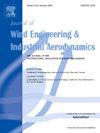窄模态柔性结构多模态涡激振动控制的tmd优化
IF 4.2
2区 工程技术
Q1 ENGINEERING, CIVIL
Journal of Wind Engineering and Industrial Aerodynamics
Pub Date : 2025-02-16
DOI:10.1016/j.jweia.2025.106043
引用次数: 0
摘要
以往针对涡激振动(VIV)控制的调谐质量阻尼器(TMDs)优化研究通常假设涡激振动受单模态控制。对于可能在多个模式下表现出viv的结构,可以基于此假设为每个模式设计单独的TMD。然而,在模态紧密间隔的结构中,由于TMD附件的存在,在特定模态锁定范围内的涡激振动响应可能同时受到主模态和其他次模态的影响,使得单模态假设不准确,基于此假设设计的TMD无效。本研究对含TMD附件的柔性结构的动振响应中的模态耦合现象进行了全面的研究。建立了一般柔性结构- tmd系统的运动方程,考虑了主结构的谐振模态和非谐振次模态。结果表明,TMD附着物可以引起各种结构的振动响应模态耦合。这些模态耦合效应的强度受到相邻模态频率的接近性和tmd质量的显著影响。导出了解耦准则,证明了通过适当定位tmd可以减轻模态耦合。提出了一种确定模态紧密间隔柔性结构多模态涡激振动控制中TMD参数的新方法,该方法通过对TMD的合理放置来保证每个TMD主要影响其目标模态,从而最大限度地减少由其安装引起的模态耦合效应。本文章由计算机程序翻译,如有差异,请以英文原文为准。
Optimization of TMDs for multimode vortex-induced vibration control of flexible structures with closely spaced modes
Previous research on optimizing tuned mass dampers (TMDs) for vortex-induced vibration (VIV) control has generally assumed that VIV is governed by a single mode. For structures that may exhibit VIVs across multiple modes, a separate TMD can be designed for each mode based on this assumption. However, in structures with closely spaced modes, the VIV response within the lock-in range of a specific mode can be influenced by both the dominant mode and other secondary modes due to TMD attachments, making the single-mode assumption inaccurate and the TMDs designed based on this assumption ineffective. This study provides a comprehensive investigation into the modal coupling phenomenon in the VIV responses of flexible structures with TMD attachments. The equations of motion for a general flexible structure-TMDs system are established, accounting for both the resonant mode and non-resonant secondary modes of the primary structure. It is demonstrated that TMD attachments can induce modal coupling in the VIV responses of various structures. The strength of these modal coupling effects is significantly influenced by the proximity of the frequencies of adjacent modes and the mass of the TMDs. A decoupling criterion is derived, demonstrating that modal coupling can be mitigated by appropriately positioning the TMDs. A novel procedure is proposed for determining TMD parameters for multimode VIV control in flexible structures with closely spaced modes, which ensures that each TMD primarily affects its target mode by strategically placing the TMDs, thereby minimizing the modal coupling effects resulting from their installation.
求助全文
通过发布文献求助,成功后即可免费获取论文全文。
去求助
来源期刊
CiteScore
8.90
自引率
22.90%
发文量
306
审稿时长
4.4 months
期刊介绍:
The objective of the journal is to provide a means for the publication and interchange of information, on an international basis, on all those aspects of wind engineering that are included in the activities of the International Association for Wind Engineering http://www.iawe.org/. These are: social and economic impact of wind effects; wind characteristics and structure, local wind environments, wind loads and structural response, diffusion, pollutant dispersion and matter transport, wind effects on building heat loss and ventilation, wind effects on transport systems, aerodynamic aspects of wind energy generation, and codification of wind effects.
Papers on these subjects describing full-scale measurements, wind-tunnel simulation studies, computational or theoretical methods are published, as well as papers dealing with the development of techniques and apparatus for wind engineering experiments.

 求助内容:
求助内容: 应助结果提醒方式:
应助结果提醒方式:


